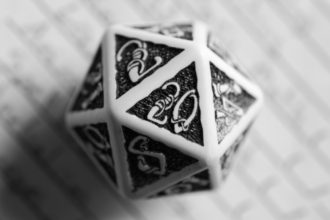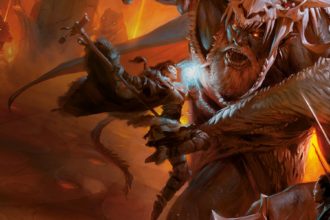In the Eye of the Beholder: Paladins

Part 1: Roleplaying a Paladin
Last week in the Eye of the Beholder, we looked at evil genies as a tool for dungeon masters running D&D campaigns. This week, we are going to move our lens over to the player’s handbook and inspect one of the classes. In this excellent series of articles, written by Brandes Stoddard, the histories of the classes are explored, with each edition from 1st to 5th given its due. Brandes chose to start with paladins, so this week we are going to explore the game-play side of paladins to complement their extensive lore. Those dungeon masters and players who are inspired by those articles, but are leery of actually roleplaying one of the notoriously difficult class, have only to read on. Those who are looking for a new take on paladins might look at the rules presented for variant 5e paladins at the end of the article.
In fifth edition, (this article assumes this is the edition that you are playing, but the first half of this article is applicable to any edition) paladins are given three sets of oaths to follow, and they may choose one. One of these oaths is extremely reminiscent of the classic paladin, the Oath of Devotion. This oath is reminiscent of the paladin’s code which paladins of previous editions strove to uphold. They held themselves as righteous warriors, affiliated strongly with the forces of law and good. The other sets of oaths, the Oath of the Ancients and the Oath of Vengeance, are more narrow in application. These oaths emulate other ideals a warrior might pledge themselves to, but with the caveat that in many ways, a player who is roleplaying a paladin sworn to one of these oaths is not a paladin, as defined by previous editions and common D&D lore. I prefer to refer to paladins of these oaths as Green Knights and Avengers respectively, although they are, by the rulebooks, paladins. It is important to remember that when roleplaying these unique offshoots of the paladin class that our ideals may not align to righteousness or valor as defined by society, and these paladins might even end up as criminals or murderers in defense of their oaths. It would not be unexpected for a paladin who took up the Oath of Ancients to be of chaotic good alignment, and a paladin of vengeance might by neutral. These characters, while still like traditional paladins in that they must uphold very specific ideals, also tend to be more free of the typical paladin woes when it comes to roleplaying.
When you sit down to play a Paladin, a shining knight of justice and good, or any other breed who remains devoted to their oaths, you may be putting yourself in a tough position. It has become common table gossip that paladins are obnoxious both to play and to play with. They are the class who most often says, “We can’t attack that sleeping dragon, it wouldn’t be fair. We should awaken it if we are going to attack it.” Oftentimes, this leads to paladins getting a bad rap amongst players. If you, or one of your players sits down to roleplay a paladin, you might offer them some of the following advice.
- “Yes, and…” A useful strategy recently covered on the Dungeon Master’s Block, the “Yes, and…” strategy involves a paladin who is does not wish to interfere with the party too much. For example, the situation might come up where a quest needs to be undertaken, but the paladin finds something objectionable about the quest. Saying “No, my character will not do that.” is an answer best saved for times when the quest is obviously in strict violation of your oaths. At other times, it would be better to agree to the quest, but simply ask that exceptions or small concessions be made so that your oath is not violated. Often, it is both easier and faster to reach a compromise that to sit there arguing – both in and out of game – with your party members.
- A life of kindness. All too often, I have seen players who are playing lawful good characters be jerks. They act arrogant, seeing themselves as moral superiors to others, and haughtily refusing to do quests that are beneath their dignity. They delight in refusing to cooperate with others, and use the excuse, “I’m just playing my character!” to justify their stubbornness. Make it clear that paladins should strive to be kind, not condescending. As harsh as they should be in their treatment of evil, they should show respect and deference to those who follow the path of good. It should be a paladin who strives to make sacrifices so that their companions can succeed, because that is what a good character who holds his honor in high regard would do.
- Don’t ignore your Oaths. I have also seen players fall into the trap of “ignoring their oaths”, which is to say, taking the “Yes, and…” strategy so far they forget the “and” half of it. They simply play fighters that can heal, and make use of the mechanical nature of the Paladin without really embracing its lore. Allowing this cursory treatment of the ethics of a Paladin is a mistake. Played correctly, the Paladin can provide a dynamic and interesting character, a counterpoint to the chaos often found in adventuring parties, and an excellent source of roleplaying material. When you notice players begin to blithely ignore their oaths, gently remind them of their driving motivations as a Paladin. If necessary, explain in detail why you feel the action they are considering is out of character. If they make the argument that their character’s interpretation of the oaths is different, however, allow them to continue so long as that argument makes sense, both in light of the oath and in light of their character’s development. You should not allow the oaths to stagnate a paladin character’s evolution, but instead use them to shape the way their character learns and perceives new situations.
In light of that last warning against forgetting your Oaths, you may be wondering, “How do I portray a blackguard, or Oathbreaker paladin, differently than any other normal bad guy?” Well, blackguards are fairly staple threats in a D&D game, and I have run more than one blackguard adversary in my years as a dungeon master. Firstly, they are a special kind of evil. They have seen good and rejected it. They have had the opportunity to save, and to experience gratitude and a life of charity and happiness, and turned away from that. That sort of intentional, systemic rejection of good is more evil that any person who was raised to be evil and has been evil their whole life. A blackguard has seen the light, and still chosen darkness. When roleplaying them, I prefer to play them as emotionless, coldhearted and calculating, save for when they burst into rage at incompotent minions or failed schemes. The best blackguard villains still have a code of honor – they are lawful evil, and enjoy twisted duels, or will never tell a lie. (But still use their words to befuddle PCs)
Part 2: Paladin Variants and a Paladin Race – The Aasimar
These paladin variants, proposed below, are a way to make your roleplaying experience when playing paladins unique. If you want to play a mounted paladin, look at the Knight build below. An urban paladin (like Batman!) for paladins who take the oath of vengeance after.
Paladin Variant: The Knight (or Cavalier)
A noble knight in shining armor is a common trope in most fantasy settings. Most are considered fighters, or paladins sworn to the Oaths of Devotion. A cavalier, however, is often uniquely focused on fighting from horseback. These characters embody the idea of a full-plated and visored warrior, charging into the battlefield astride a huge destrier. Sometimes, this might not be an appropriate build for a dungeon delving game, or one where you could not commonly be mounted. This is also much more applicable if you, or your DM (as a player), allow feats. I would build a cavalier as a Paladin sworn to the Oath of Devotion, but keep in mind that your Oath of Devotion might be to a king or church. (If you were a knight, for example.) This allows unique conflicts between your superiors, who might not be so kindhearted as you, and your devotion to good. A Paladin of Tyr, sworn to the Church of the Silver Hand, with the Mounted Combatant and Polearm Master feats, as well as the namesake “knight” background is an excellent Cavalier.
Paladin Variant: Urban Paladin
Some settings require a slightly grittier paladin, one who can hold his nose when talking to known criminals, just so he can find out the whole organization’s plan. When you want to play a paladin who is willing to go to any lengths, even soiling his own hands, to defeat criminals (usually in an urban setting), consider taking the Oath of Vengeance. Such a Paladin could lie, or even join criminal organizations only to betray them later. This paladin works as an excellent grey knight, someone who does evil to uphold good, taking the law into their own hands. Batman is an excellent example of an Urban Paladin, save that he doesn’t use magic or fight with a sword. Normally, paladins in the past have suffered in campaigns of intrigue and subtlety, but this type of Paladin, taking the “urchin” background, can easily fit into that type of campaign, while still allowing you to play a paladin mechanically.
Character Race: The Aasimar
If your paladin PCs or NPCs are looking for a race whose temperament best suits being a paladin, and then you might recommend the Aasimar. Aasimar are humans, drawn from an Angelic bloodline. An Angel’s child (a half-celestial) who breeds with humans has Aasimar children, who appear much like other humans, save for having distinctive features that might include any of the following: golden eyes, bright hair almost reminiscent of a halo, unusual grace, strange skin patterns and coloring, and distinctive, almost sculpted, features. Aasimar feel a pull towards the alignments of good and law, and often aspire to be paladins or knights. As such, they are often respected in places where angels are admired, but shunned in cities with an evil bent, such as those of the Drow or slaver’s cities like Athkatla. Some Aasimar dislike the expectation the world puts upon them, as they are almost always assumed to be heroic paladins, even when they do not fit the mold. Aasimar can be of any alignment, but those who are not lawful good tend to be bitter and angry, upset by a world with expectations too high for them to reach. For example, an Aasimar who takes up carpentry is all too often confronted with villagers who are looking for a knight to defend them from orcs, bandits or other monsters. Aasimar often draw their names from their human side, although some who aspire to emulate their heavenly ancestors might include their angelic name, if it is known. Others take up names after their features, such as Brighteyes and Sunskin.
For Aasimar Stat see page 286 of the Dungeon Master’s Guide for D&D Fifth Edition.
Don’t forget to check out the History of the Classes: The Paladin Class



